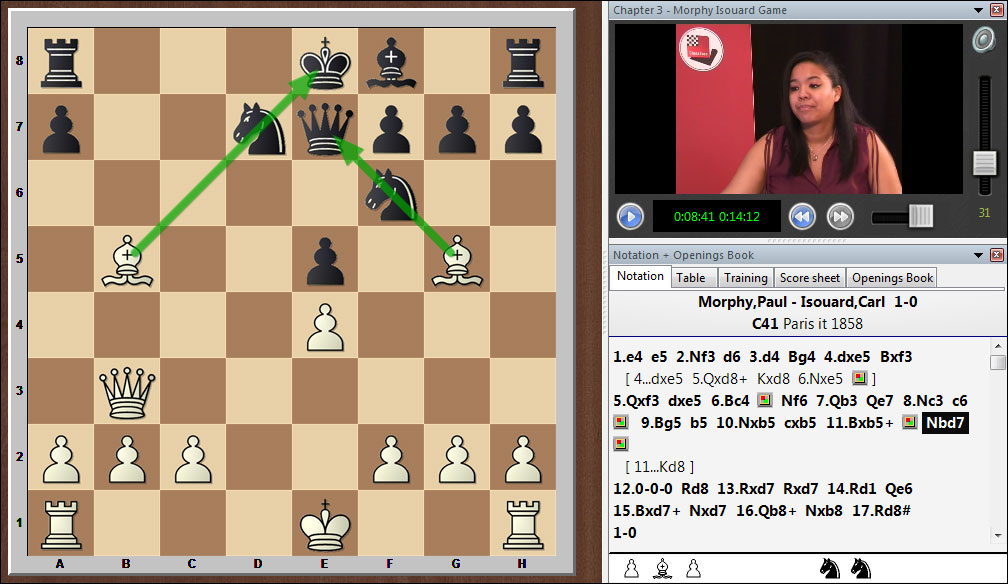


This DVD is for anyone who knows the rules of chess but would like to be able to improve their game with some specific tactics and strategies. It builds on the basic principles of chess that should have already been learnt.
To start with, you might wonder who is considered a ‘novice’. Is a ‘novice’ different from a ‘beginner’? Although there is a thin line between the two words, and they are often used interchangeably, if looking for a linguistic precision, a ‘novice’ is considered one level up from a ‘beginner’. One that has passed the most basic level of understanding and has proceeded to more advanced concepts but still has a lot to learn. In most cases, improving amateur chess aficionados would fall in this group. No need to flatter ourselves for knowing more than the basics; there is always room to improve, to brush up on a problematic position or even to get acquainted with completely new one.
This DVD is for anyone who knows the rules of chess but would like to be able to improve their game with some specific tactics and strategies. It builds on the basic principles of chess that should have already been learnt.

Anyone willing to open up their minds to further learning, to enhance their understanding of the expansive chess universe would benefit from the material presented in this FritzTrainer entitled ‘Chess for Novices’ by Sabrina Chevannes.
Youngsters would appear to be the most obvious students of ‘Chess for Novices’ which is presented in two DVDs (or digital downloads), as Volume 1 and Volume 2. But, I would say that late starters or adults who are interested in refreshing their chess knowledge of some past years, would also find it highly beneficial. The material reads a bit like ‘everything you ever wanted to know about chess but were afraid to ask’. All answers are there for those of you inclined to follow the course in full — over four hours for each volume — absorbing instructions about the basic chess theory.
In uncertain times, with tournaments being cancelled left and right, it's an ideal time to entertain some intellectual activity from the comfort of your own home.
For those slightly stronger players, if at first, you perceive the series as containing too much basic information, don't fret — I am sure you will find there are many ideas you were not aware of, if only for the terminology of chess theory that Chevannes uses. For example, I am not sure that the many types of ‘forks’ are known under their proper names. Most would be familiar with a ‘knight fork’ as a general concept, but did you know that when a knight produces a fork on the queen and the king, or the queen and the rook, it is called ‘royal fork’? Or that, when it attacks simultaneously three pieces, the Queen, the King and the Rook, it is called a ‘family fork’?
It might sound over simplistic, but distinguishing various structures with their proper names, illustrated with examples and explanations helps to retain patterns and reoccurring chess positions more easily. It also aids development of a very important ability that the author emphasizes: visualization.
In four chapters — Revision, Opening Principles, Basic Tactics and Basic Endgame Checkmates — Chevannes gives very clear demonstrative examples explaining, in minute detail, all possible structures that may appear in a chess game. Nothing is omitted — starting with the most basic notions of the coordinates and the value of pieces, through positions with check, checkmate, stalemate, castling, en passant, pins, forks, skewers and pawn promotion we are led further into more substantial operations: taking control of the centre, development of the pieces, gaining tempi, finishing development, discovered attack and discovered check, finishing with Basic Checkmate Endings including Lawnmower Checkmate, Shadow Mate and Box Checkmate.
Towards the middle, the material gets denser and progressively more difficult in content. After the basic information is exhausted, Chevannes starts exploring specific topics practically, analysing positions and games.
Perhaps the most famous game in chess, Morphy vs Isouard (Paris, 1858), which is normally seen as an example of masterly virtuosity, here is given a very useful, highly educative make-over. Chevannes brings out Morphy’s real significance in chess theory: he was not only an attacking player, but he was the first one to point out the importance of opening principles and development. Morphy is not just playing moves for the sake of creating a sensation, but there is a deep logic behind them that is explained in a thorough analysis, emphasizing the positional opening principles, the development of pieces and using the pin to pile up pressure until the opponent scrambles to an unavoidable checkmate.

Morphy — Development Move
In the above diagram, White has a free pawn on b7. The majority of players would happily capture that pawn. Not Morphy. Capturing the b7 pawn would not help White’s development nor would it create more meaningful threats. Morphy plays Nc3, which is another developing move.

Morphy — Sacrificing a piece
Later in the game, as seen on the above diagram. Morphy is not concerned about his Bishop being threatened. He considers his opponent’s underdevelopment and decides it is a good moment to sacrifice a piece. We are at move 9…b5. The game continues: 10.♘xb5 cxb5 11.♗xb5+ ♞bd7.

Morphy — Double Pin
At this point, Morphy has created a double pin against his still underdeveloped opponent. He does not capture either piece; he just builds up pressure and makes a further developing move, 12. 0-0-0 in order to create a fool-proof checkmating attack.
You can enjoy the amazing sequence of moves, a result of a carefully built up position, and, of course, of Morphy’s genius.
Master Class Vol.9: Paul Morphy
Learn about one of the greatest geniuses in the history of chess! Paul Morphy's career (1837-1884) lasted only a few years and yet he managed to defeat the best chess players of his time.
For the full backstory to this game see 50 games you should know: Morphy vs. Duke of Brunswick, Count Isoard
Chevannes’ wonderfully confident and fluent presentation must come from her many years experience as a professional coach and teaching chess in schools. Her knowledgeable, upbeat instructions are quite engaging. You may be surprised how many gaps you will discover in your chess knowledge that could do with some filling. Her delivery is charming but firm, like an authoritative school teacher. When she gives instructions about how to solve the puzzles in the tests at the end of the FritzTrainer, she reminds you of the obvious: "If you cannot solve the test, please go back to the chapter treating that subject to learn it properly".
At the end, Chevannes confidently assures you: "You are now prepared to enter tournaments and meet much stronger players. But, please review the sections that you are unsure of and keep watching them over and over again until you are definitely confident with all the material in this [series]."
Our teacher knows her job well and what is needed for further improvement. For those who want to go further, there is a sequel, ‘Chess for Novices 2’, which may be worth a look.
This DVD follows on from the material learnt in Volume 1 of the Chess for Novices series. The format of the DVD is the same and has 4 chapters split into Opening, Middlegame, Endgame and the test section.